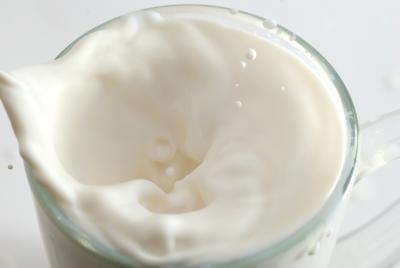
Overview
A variety of conditions can cause dark circles or puffiness under your eyes. Genetics, nasal congestion, environmental allergies, eczema, lack of sleep, alcohol abuse, poor hydration and nutritional deficiencies can all contribute to the appearance of dark circles under the eyes, according to MayoClinic.com. For some people, dark circles may occur as part of an allergic or hypersensitive response to particular foods. The darkness occurs because the skin under the eyes becomes inflamed. Touching or rubbing the irritated skin makes the circles worse. While over 140 foods cause allergic responses, about 90 percent of food allergies are caused by just a few types of food, according to the World’s Healthiest Foods website.
Dairy
Dairy allergies are fairly common. In addition to dark eye circles, other symptoms may include indigestion, nausea, cramps, diarrhea, rashes, hives, congestion, tightness in the chest and asthma attacks. Some people develop these adverse responses because they are allergic to the casein or whey proteins that are found in milk. A closely related condition, lactose intolerance, occurs in people who lack the lactase enzyme that breaks down lactose in milk. Lactose intolerance causes indigestion but it does not involve the immune system and doesn’t directly cause dark circles under the eyes.
Tyramine Sensitivity
Certain foods contain an amino acid called tyramine that triggers an inflammatory response from the immune system in sensitive persons. Foods that contain tyramine include sausage, chocolate, sour cream, red wine, avocado, beer, raspberries, yeast and pickled herring, reports the World’s Healthiest Foods website. Tyramine is also contained in soy-based, processed and aged cheeses, including Romano, Asiago, American, Gouda, Roquefort, Provolone, Colby and Parmesan.
Wheat
Gluten is a substance found in wheat, wheat flour, wheat products, barley and rye. Primarily comprised of protein, gluten triggers an immune system response in sensitive people. Gluten sensitivity does not qualify as a true allergic response because the body does not necessarily produce specific antibodies in response to the gluten. Nonetheless, the reactions to gluten can be systemic, causing inflammation of skin, as well as other symptoms. Read ingredient labels carefully because many processed foods contain gluten or wheat products.
Preservatives and Additives
Preservatives and additives such as sodium benzoate, butylated hydroxytoluene salicylates and dyes can cause hives or other intolerance reactions in sensitive persons, reports the World’s Healthiest Foods website. Avoid processed foods and read ingredient labels when you do choose to eat food from a box.
Further Allergens and What to Do
Hen’s eggs; citrus fruits; soy and soy products; peanuts;, shell fish such as prawns, lobster, crab, clams and shrimp; and tree nuts, such as almonds pecans, cashews, walnuts, Brazil nuts, pistachios, chestnuts and hazelnuts, all can trigger inflammation in sensitive individuals.
Begin eliminating foods that may contribute to dark circles from your diet, monitoring how the circles and your other symptoms respond. If they improve, then slowly reintroduce the foods, one by one, back into your diet. If the circles and other symptoms return, then eliminate that food from your diet. Speak with your doctor about your concerns before making drastic changes to your diet.
Begin eliminating foods that may contribute to dark circles from your diet, monitoring how the circles and your other symptoms respond. If they improve, then slowly reintroduce the foods, one by one, back into your diet. If the circles and other symptoms return, then eliminate that food from your diet. Speak with your doctor about your concerns before making drastic changes to your diet.





No comments:
Post a Comment